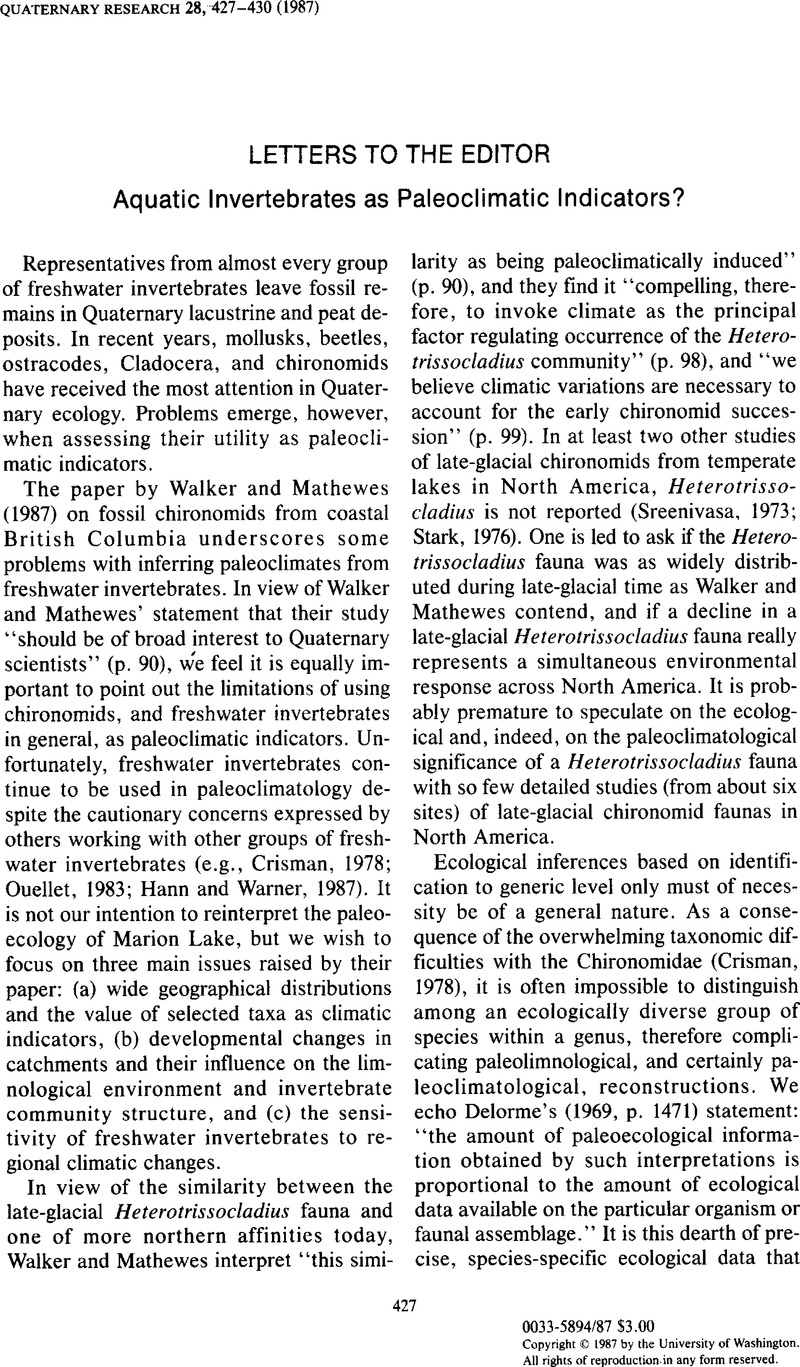Crossref Citations
This article has been cited by the following publications. This list is generated based on data provided by Crossref.
Walker, Ian R.
and
Mathewes, Rolf W.
1987.
Chironomids, Lake Trophic Status, and Climate.
Quaternary Research,
Vol. 28,
Issue. 3,
p.
431.
Warwick, William F.
1989.
Chironomids, lake development and climate: a commentary.
Journal of Paleolimnology,
Vol. 2,
Issue. 1,
p.
15.
Walker, Ian R.
and
Mathewes, Rolf W.
1989.
Early postglacial chironomid succession in southwestern British Columbia, Canada, and its paleoenvironmental significance.
Journal of Paleolimnology,
Vol. 2,
Issue. 1,
p.
1.
Walker, Ian R.
and
Mathewes, Rolf W.
1990.
Paleolimnology and the Reconstruction of Ancient Environments.
p.
147.
Warwick, William F.
1990.
Paleolimnology and the Reconstruction of Ancient Environments.
p.
161.
Davis, Ronald B.
1990.
Paleolimnology and the Reconstruction of Ancient Environments.
p.
1.
Walker, Ian R.
Smol, John P.
Engstrom, Daniel R.
and
Birks, H. J. B.
1991.
An Assessment of Chironomidae as Quantitative Indicators of Past Climatic Change.
Canadian Journal of Fisheries and Aquatic Sciences,
Vol. 48,
Issue. 6,
p.
975.
Hann, B. J.
and
Karrow, P. F.
1993.
Comparative analysis of cladoceran microfossils in the Don and Scarborough Formations, Toronto, Canada.
Journal of Paleolimnology,
Vol. 9,
Issue. 3,
p.
223.
Levesque, André J.
Cwynar, Les C.
and
Walker, Ian R.
1997.
Exceptionally steep north–south gradients in lake temperatures during the last deglaciation.
Nature,
Vol. 385,
Issue. 6615,
p.
423.
Korhola, A.
Birks, H. J. B.
Olander, H.
and
Blom, T.
2001.
Chironomids, temperature and numerical models: a reply to Seppälä.
The Holocene,
Vol. 11,
Issue. 5,
p.
615.
BRODERSEN, KLAUS PETER
and
ANDERSON, N. JOHN
2002.
Distribution of chironomids (Diptera) in low arctic West Greenland lakes: trophic conditions, temperature and environmental reconstruction.
Freshwater Biology,
Vol. 47,
Issue. 6,
p.
1137.
Velle, Gaute
Brooks, Stephen J.
Birks, H.J.B.
and
Willassen, Endre
2005.
Chironomids as a tool for inferring Holocene climate: an assessment based on six sites in southern Scandinavia.
Quaternary Science Reviews,
Vol. 24,
Issue. 12-13,
p.
1429.
Woodward, C. A.
and
Shulmeister, J.
2006.
New Zealand chironomids as proxies for human-induced and natural environmental change: Transfer functions for temperature and lake production (chlorophyll a).
Journal of Paleolimnology,
Vol. 36,
Issue. 4,
p.
407.
Belyea, Lisa R.
2007.
Revealing the Emperor's new clothes: niche-based palaeoenvironmental reconstruction in the light of recent ecological theory.
The Holocene,
Vol. 17,
Issue. 5,
p.
683.
Nazarova, L. B.
Pestryakova, L. A.
Ushnitskaya, L. A.
and
Hubberten, H. -W.
2008.
Chironomids (Diptera: Chironomidae) in lakes of central Yakutia and their indicative potential for paleoclimatic research.
Contemporary Problems of Ecology,
Vol. 1,
Issue. 3,
p.
335.
Eggermont, Hilde
Heiri, Oliver
Russell, James
Vuille, Mathias
Audenaert, Leen
and
Verschuren, Dirk
2010.
Paleotemperature reconstruction in tropical Africa using fossil Chironomidae (Insecta: Diptera).
Journal of Paleolimnology,
Vol. 43,
Issue. 3,
p.
413.
Eggermont, Hilde
and
Heiri, Oliver
2012.
The chironomid‐temperature relationship: expression in nature and palaeoenvironmental implications.
Biological Reviews,
Vol. 87,
Issue. 2,
p.
430.
Liu, Yuanyuan
Chen, Guangjie
Hu, Kui
Shi, Haibin
Huang, Linpei
Chen, Xiaolin
Lu, Huibin
Zhao, Shuaiying
and
Chen, Li
2017.
Biological responses to recent eutrophication and hydrologic changes in Xingyun Lake, southwest China.
Journal of Paleolimnology,
Vol. 57,
Issue. 4,
p.
343.



